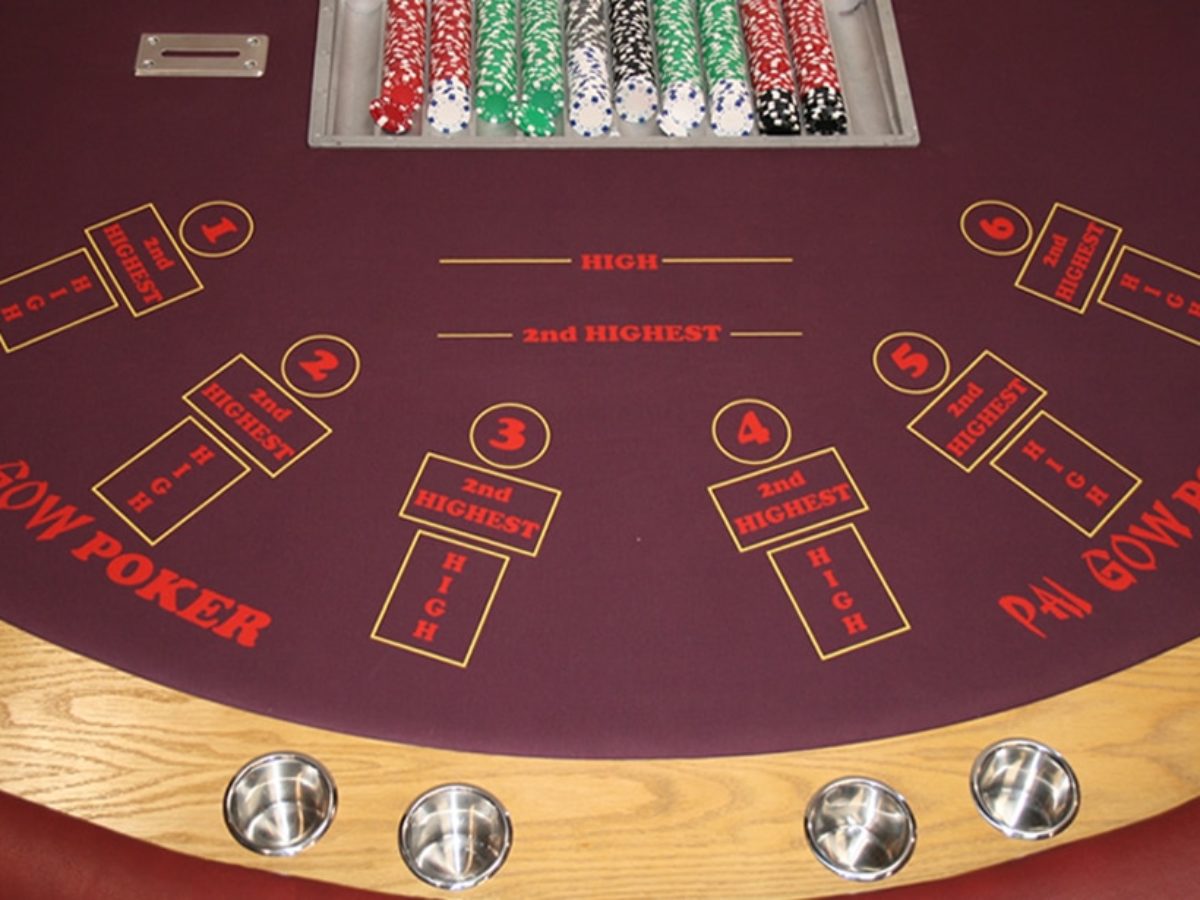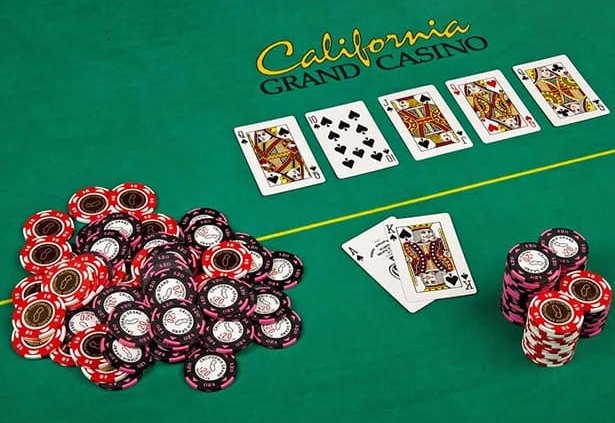- How to Play Pai Gow Poker. Pai Gow Poker uses a standard deck of 52 cards plus one joker. A maximum of six players sit around the table along with the dealer. The object of the game is quite simple: to beat the banker. The banker can be the dealer, another.
- Pai Gow Poker Rules – Learn How to Play Pai Gow Poker Pai Gow Poker is one of those Americanized Chinese gambling games that today are part of almost every casino. This game is a social game just as poker and can be played by six players simultaneously using a 52-card deck.
About the tile game of Pai Gow. Here's what you can do on PaiGow.com: Learn to play Pai Gow like an expert. Our 400 pages of online tutorials will teach you everything you need to know. Experienced players: Improve your odds with the Denenberg Strategy. Exciting news: exclusively on PaiGow.com, you can now learn an improved Pai Gow strategy, designed by computer, that works much better than.
In China, pai gow is a popular gambling game played with Chinese dominoes. In 1985, Sam Torosian, owner of the Bell Card Club, created a poker game inspired by pai gow—he called it “pai gow poker.” It’s become a popular game in casinos throughout the United States.
Like blackjack, pai gow poker is a game of skill, where your decisions matter. It’s also a slow-paced game, and the probability of getting into a “push” situation (a tie) is relatively high. For someone with a small bankroll, pai gow poker can be one of the best deals in the casino.

But pai gow poker is also more complicated to play than many other casino card games. Playing well is another magnitude of difficulty. This post aims to provide everything you need to know to get started playing pai gow poker without making a fool of yourself.
How to Play Pai Gow Poker
Pai gow poker is played with a standard 53-card deck of cards. (“53” is not a typo—it’s a 52-card deck with the addition of a joker.)
In most card games, jokers are “wild cards”—they can stand in for any card you need them to.
But in pai gow poker, jokers are only wild for certain situations. Here’s how you can use a joker in pai gow poker:
- You can use it as an ace.
- You can use it to complete a straight.
- You can use it to complete a flush.
- You can use it to complete a straight flush.
The game starts with the players making bets. Then the dealer and the players each get 7 cards.
As with most poker games, even house-banked games, the standard ranking of poker hands is used, with one exception:
After you get your 7 cards, you must “set your hand.” This means you divided your hand into 2 hands—a 5-card hand and a 2-card hand. You have a lot of freedom for setting the hand, but you must follow one restriction:
The 5-card hand must have a better poker hand ranking than the 2-card hand.
Of course, the 5-card hand is treated like a 5-card poker hand. The 2-card hand can only qualify for 2 poker hand rankings, though—a pair, or not a pair.
The dealer also sets his hand, but he must follow specific rules set by the casino. This is called “the house way.” It’s comparable to how a blackjack dealer must play his hand in a prescribed manner.
When you compare hands, you have the following possibilities:
- Both of the player’s hands beat both of the dealer’s hands.
- One of the player’s hands beats the dealer’s hand, but one of the dealer’s hands beats the player’s hand.
- Both of the dealer’s hands beat both of the player’s hands.
If both of the player’s hands beat the dealer’s hand, he wins even money less a 5% commission on his bet.
If both of the dealer’s hands beat the player’s hand, the player loses his bet.
But if one hand is a winner and the other is a loser, the bet is considered a “push.” This means the player gets to keep his bet, but he doesn’t get any winnings in addition to that.

Also, ties go to the banker.
40% of the time, the outcome is a push, which is huge. At most pai gow poker tables, you’ll see 30 hands per hour. If 12 of them are ties, you’re only looking at 18 hands per hour with a win or loss.
This kind of thing matters a lot when you’re trying to track how much money per hour it costs to play a specific casino game. In blackjack, for example, you’re liable to see 100 hands per hour, but most of them won’t result in a push.
I like leisurely games where I don’t lose a lot of money at once. Pai gow poker fits the bill nicely.
Banking in Pai Gow Poker
In most casino games, the betting is pretty straightforward. You’re the player, and you bet against the dealer. In pai gow poker, though, you have the option to bet against the dealer and the other players. Only one player gets to be the banker on each hand, though—the opportunity rotates.
Here’s the thing about being the banker in pai gow poker, though—it requires (as you might expect) a large bankroll. Most people just decline the opportunity to be the banker.
If you do choose to play as the banker, you can set your hand any way you like. You’re not required to follow the house way.
Being able to play as the banker enables players to get a small edge, especially if you’re playing with other players who are beginners and aren’t good at the game. The strategy in pai gow poker stems from how you’re able to set your hands.
The House Edge in Pai Gow Poker
The house edge is the long-term expected win for the casino expressed as a percentage. It’s a forecast and an estimate, but it only applies in the long run—over the course of thousands of hands. Still, it’s good information to have about a casino game.
Generally, the lower the house edge, the better the game is for the player. For example, the house edge in blackjack is usually around 1%, but that assumes the use of perfect basic strategy. This means that every time you place a $100 bet, the casino expects to win an average of $1.
The house edge in pai gow poker varies based on a couple of things. One of these is how good you are at setting your hand. The other is how often you can afford to play as the banker.
Generally, the house edge in pai gow poker is 2.7%, although it’s much lower when playing as the banker. This estimate assumes you’re just following the house way strategy. If you can play more optimally than that, you can whittle the house edge down by another 0.2%.
And if you’re playing as the banker and using optimal strategy, the house edge is even lower—around 0.3%. If you can find a table where the other players aren’t very good at setting hands, you might even be able to get a long-term advantage. This is an example of an advantage gambling technique.
Pai Gow Poker Strategy for Setting Your Hand
For most recreational gamblers, a strategy similar to the house way is sufficient. Getting any more optimal than that is more trouble than it’s worth for the tiny gain in expectation. Below I’ve outlined one common house way of setting hands.
To understand this guide to pai gow poker strategy, you should know which hand is your “front” hand and which hand is your “back” hand. Luckily, this isn’t complicated.
The front hand is your 2-card hand.
The back hand is your 5-card hand.
Here’s how to play with close to correct pai gow poker strategy:
First, if you have no pairs at all in your 7 cards, put the highest card in your front hand. Put the next 2 highest cards in your back hand.
If you have one pair, always put it in your back hand. Then put your 2 other highest cards in your back hand.
If you have 2 pairs, you’ll put one pair in your back hand and the other in your front hand. The higher ranked pair goes in your back hand, and the lower ranked pair goes in your front hand. But sometimes, you’ll want to keep both pairs in your back hand.
You’ll do this if you have a pair of 7s and no ace. You’ll also do this if you have a pair of jacks or better AND a pair of 6s or better along with an ace. And finally, you’ll do this if you have a pair of aces and any other pair.
If you get 3 pairs, put the highest-ranked pair in your front hand. The other 2, of course, go in your back hand.
If you have 3 of a kind, put all 3 of those cards in your back hand UNLESS you have 3 aces. In that case, you put an ace in your front hand and 2 aces in your back hand.
If you have a 3 of a kind AND a 2nd 3 of a kind, put the lower-ranked 3 of a kind in your back hand. Then split up the 2nd 3 of a kind so that you’ll have a pair in your front hand.
If you get a full house, split it up so that you have a pair in your front hand and 3 of a kind in your back hand.
If you get a straight, flush, or a straight flush, you should always keep those 5 cards together in your back hand.
If you have a 4 of a kind, how you play it depends on the ranks of the cards. If they’re 6 or lower, you’ll keep the 4 of a kind together in your back hand. If they’re 7, 8, 9, or 10, you should split them unless you have an ace, in which case you keep them together and put the ace in your front hand.
If you have a 4 of a kind consisting of face cards, split them unless you also have a pair of 10s or higher. And if you have 4 aces, split them unless you have a pair of 7s or higher.
If you get 5 aces, you should split them unless you have a pair of kings to put in your front hand.
How To Play Pai Gow Card Game
Besides that, you should always play as the banker if you can afford to, because of the much lower house edge. This isn’t an option when playing in an online casino, but it’s an option at most traditional brick and mortar casinos.
Conclusion
If you’re looking for affordable entertainment in the form of casino gambling, you’ll have a hard time finding a better game than pai gow poker. A house edge of 2.7% sounds high, but it’s really not bad at all when you consider that 40% of the hands you’ll play will be a push.
Optimal strategy for pai gow poker is more complicated than the house way, but if you just play by the house way, you’ll be doing better than most other players at the table. Consider using the house way strategy provided in this post next time you play.
How To Play Pai Gow Poker And Win
Finally, one of the biggest distinctions between pai gow poker and other casino games is the ability to play as the banker. You should take advantage of this as much as possible, but you’ll probably only be able to if you’re a high roller with a huge bankroll.